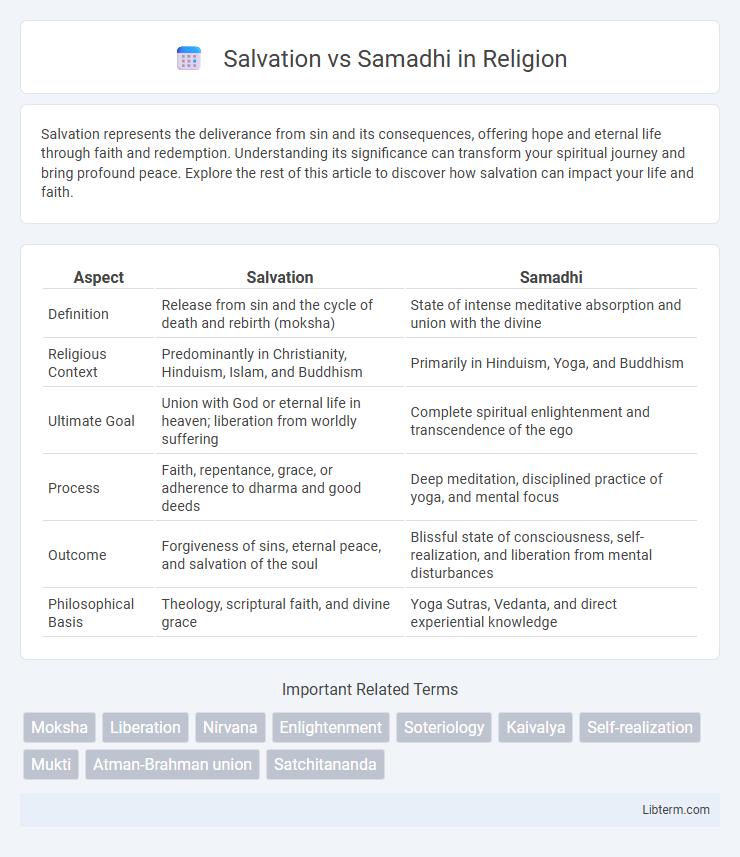Salvation represents the deliverance from sin and its consequences, offering hope and eternal life through faith and redemption. Understanding its significance can transform your spiritual journey and bring profound peace. Explore the rest of this article to discover how salvation can impact your life and faith.
Table of Comparison
| Aspect | Salvation | Samadhi |
|---|---|---|
| Definition | Release from sin and the cycle of death and rebirth (moksha) | State of intense meditative absorption and union with the divine |
| Religious Context | Predominantly in Christianity, Hinduism, Islam, and Buddhism | Primarily in Hinduism, Yoga, and Buddhism |
| Ultimate Goal | Union with God or eternal life in heaven; liberation from worldly suffering | Complete spiritual enlightenment and transcendence of the ego |
| Process | Faith, repentance, grace, or adherence to dharma and good deeds | Deep meditation, disciplined practice of yoga, and mental focus |
| Outcome | Forgiveness of sins, eternal peace, and salvation of the soul | Blissful state of consciousness, self-realization, and liberation from mental disturbances |
| Philosophical Basis | Theology, scriptural faith, and divine grace | Yoga Sutras, Vedanta, and direct experiential knowledge |
Understanding Salvation: A Spiritual Overview
Salvation in spiritual traditions refers to liberation from the cycle of birth and death, often achieved through divine grace, self-realization, or moral purity. It embodies eternal freedom and unity with the ultimate reality or God, transcending worldly suffering and ego-based identity. Understanding salvation involves recognizing its emphasis on unconditional surrender, faith, and transformative spiritual awakening beyond mere meditative absorption or contemplative states like samadhi.
Defining Samadhi in Eastern Philosophy
Samadhi in Eastern philosophy refers to a profound state of meditative absorption where the mind becomes completely still and merges with the object of meditation, transcending individuality and duality. It is considered the ultimate goal of yogic practice and is described extensively in Patanjali's Yoga Sutras as the eighth and final limb of Ashtanga Yoga. Unlike salvation, which often implies deliverance or liberation from sin in Western religious traditions, Samadhi emphasizes direct experiential realization of oneness and enlightenment within the present moment.
Historical Origins: Salvation and Samadhi
Salvation, rooted in Abrahamic traditions such as Christianity, Judaism, and Islam, historically emphasizes deliverance from sin and eternal union with God through faith and divine grace. Samadhi originates in ancient Indian spiritual practices, especially within Hinduism, Buddhism, and Jainism, representing the highest state of meditative absorption and self-realization. Both concepts, emerging from distinct religious frameworks, reflect profound spiritual liberation but differ fundamentally in their metaphysical goals and historical development.
Core Beliefs: Christian Salvation vs Eastern Samadhi
Christian salvation centers on redemption through faith in Jesus Christ, emphasizing forgiveness of sins and eternal life as core beliefs. Eastern Samadhi, rooted in Hinduism and Buddhism, focuses on achieving a profound state of meditative absorption and spiritual enlightenment, transcending the ego and material existence. Both concepts underscore transformation, but salvation entails divine grace and moral reconciliation, while Samadhi involves self-realization and inner tranquility.
The Pathway to Salvation: Faith and Grace
The pathway to salvation centers on faith in divine grace, emphasizing belief in a higher power's mercy rather than personal effort alone. Salvation is often seen as a gift freely given to those who trust in the spiritual teachings and divine promise, contrasting the self-realization approach of Samadhi. Scriptural texts like the Bible highlight faith and grace as essential elements for attaining eternal life and spiritual liberation.
Attaining Samadhi: Meditation and Mindfulness
Attaining Samadhi involves deep meditation and sustained mindfulness, enabling practitioners to transcend ordinary consciousness and achieve profound states of inner stillness and unity. Techniques such as focused breath awareness and mindful observation of thoughts cultivate heightened concentration, gradually dissolving mental distractions and egoic attachments. This disciplined meditative practice contrasts with Salvation, which often emphasizes spiritual liberation through faith or grace rather than direct experiential absorption into divine consciousness.
Key Differences Between Salvation and Samadhi
Salvation primarily refers to the liberation from the cycle of birth and death (moksha) in religious contexts, often emphasizing eternal union with a divine entity or God. Samadhi, in contrast, denotes a profound state of meditative absorption in yoga and Vedanta, characterized by complete mental stillness and self-realization without necessarily involving devotional aspects. While salvation is goal-oriented with a spiritual or soteriological endpoint, samadhi is an experiential state achieved through disciplined meditation and spiritual practice.
Similarities in Spiritual Liberation
Salvation and Samadhi both represent profound states of spiritual liberation characterized by the transcendence of ego and attachment to the material world. These experiences involve achieving a deep inner peace and unity with the divine or ultimate reality, facilitating the dissolution of suffering and ignorance. Both concepts emphasize freedom from the cycle of birth and death, leading to eternal bliss and self-realization.
Salvation and Samadhi in Modern Practices
Salvation in modern spiritual practices often emphasizes personal liberation from suffering and the cycle of rebirth through faith, ethical living, and devotion as seen in contemporary Christian and Hindu communities. Samadhi, integral to contemporary yoga and meditation movements, is understood as a state of intense meditative absorption leading to self-realization and inner peace, achieved through disciplined practice of mindfulness and concentration techniques. Modern practitioners frequently blend these concepts, seeking both the transcendental union of Samadhi and the transformative redemption offered by Salvation for holistic spiritual growth.
Choosing Your Path: Personal Spiritual Fulfillment
Choosing between salvation and samadhi centers on personal spiritual fulfillment, where salvation often emphasizes liberation through faith and grace in religious traditions, while samadhi represents a state of deep meditative absorption and self-realization in yogic practice. Individuals seeking salvation might prioritize divine connection and eternal life, whereas those drawn to samadhi focus on transcending ego and attaining inner peace through disciplined meditation. Understanding these distinct paths enables a tailored approach to spiritual growth aligned with one's beliefs and experiences.
Salvation Infographic

 libterm.com
libterm.com